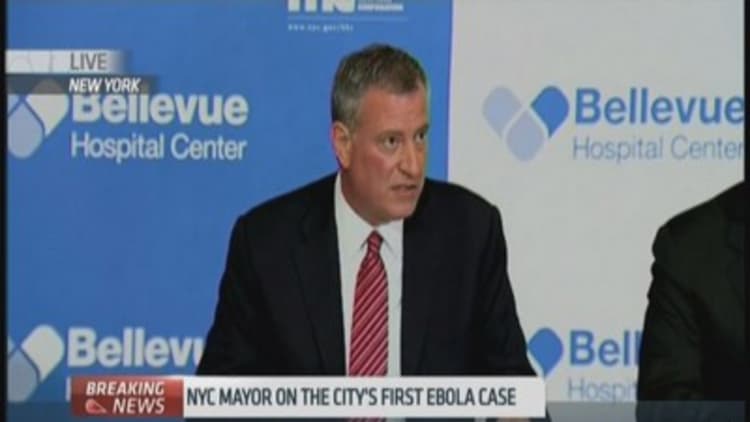New York City's first confirmed case of Ebola has raised complicated logistical issues of how to trace the possible contacts of an infected patient in a city of more than 8 million people with a sprawling mass transit system and a large population of workers who commute every day from surrounding suburbs and states.
By the time the patient, Dr. Craig Spencer, an emergency doctor who had recently returned from Guinea, arrived at Bellevue Hospital Center in Manhattan by ambulance on Thursday, he was seriously ill, officials said.
Read MoreNYC doctor tests positive for Ebola: Officials
Dr. Spencer complicated the tracing process when he told health officials that just the night before, he had gone bowling in Brooklyn, making the long trip there from his home in Upper Manhattan by subway and then returning in a car hired via the taxi service Uber.
City health officials were suddenly faced with the challenge of finding the right balance between trying to find everyone who might have been exposed and responding to a disease that is transmitted only through direct exposure to bodily fluids.
It was soon clear that health authorities had other worries, as word emerged that they were isolating not just Dr. Spencer's fiancée but also two friends who had been with him in the two days before he arrived at the hospital. Dr. Spencer said he had started feeling sluggish on Tuesday.
Read MorePaul Allen pledges $100 million to fight Ebola
City officials were making plans to provide case managers for every family or person who might need to be quarantined. Those managers would help with the chores of daily life, such as providing school materials for children or food for people confined to their homes.
New York has some advantage in that it may be able to learn from what happened in Dallas, where two nurses became infected with Ebola after treating Thomas E. Duncan, the patient with the first case of Ebola to be diagnosed in the United States who died on October 8.
More from the New York Times:
Craig Spencer, doctor in New York City, is sick with Ebola
Neighbors say Ebola patient is fast to lend a helping hand
Can you get Ebola from a bowling ball?
Israel Miranda, president of the union of uniformed emergency medical technicians and paramedics, said on Thursday that he was satisfied with the way Dr. Spencer's transportation to the hospital had been handled.

Two ambulances responded, and two paramedics fully encased in protective suits brought Dr. Spencer out of his apartment on West 147th Street; two others who were not in suits drove.
When the paramedics left the hospital, their suits were sprayed with disinfectant and cut off from behind by a special unit, Mr. Miranda said. The ambulance was also decontaminated.
"The suit was peeled off them like an onion," he said. "So everything went by the book."
Read MoreAmid Ebola crisis, is something worse around corner?
He said the paramedics would have their temperatures taken twice a day for 21 days to ensure they had not been infected, but in the meantime they would be free to continue responding to calls because "there was no breach."
Soothing the fears of those who may have been at the Gutter, the Brooklyn bowling alley Dr. Spencer visited, or who might have ridden in a subway car with him could well be more challenging.
In the Dallas case, the Frontier Airlines plane on which an infected nurse flew was taken out of service and decontaminated in a process that included replacing seat covers and the carpet area near the nurse's seat. The airline said it had gone to great lengths to ease customer's fears.
Yet cruise ship officials were widely ridiculed for overreacting when they decontaminated a ship on which a lab technician traveled after coming into contact with specimens taken from Mr. Duncan before his death.
Dr. Spencer has been isolated in a seventh-floor ward at Bellevue, the city's main public hospital, that was specially designed to treat highly infectious tuberculosis patients. The unit is locked and guarded, with rooms where health care workers can be decontaminated and cameras can monitor patients remotely.

